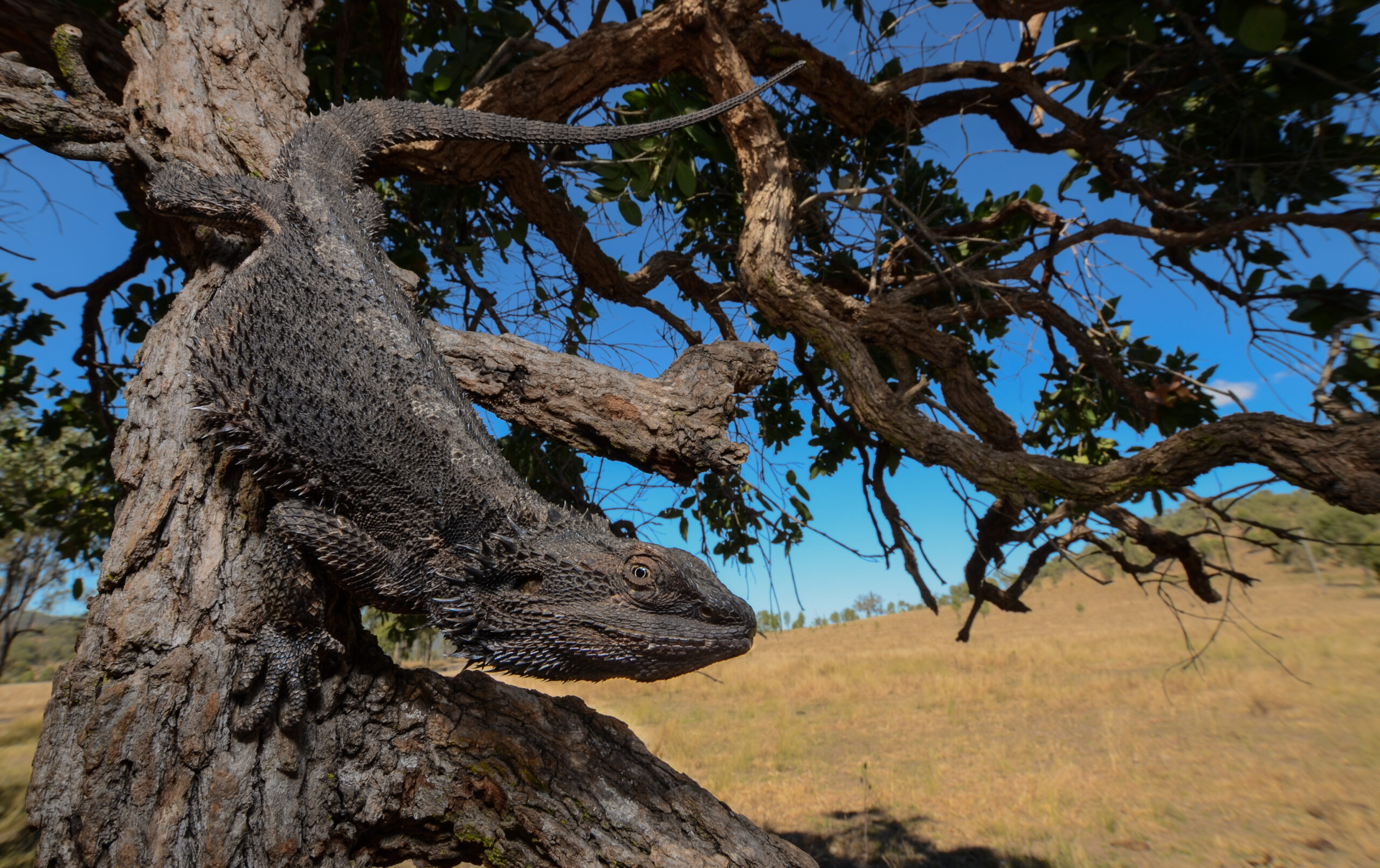When sunlight warms the dry eucalypt forests and open paddocks of eastern Australia, the Eastern Bearded Dragon makes its appearance. Head held high, body flattened to soak up the morning rays, it is a familiar and charismatic figure across rural landscapes and bushland edges. This lizard, with its spiny armour and expressive beard, is more than just a striking reptile – it is a symbol of the Australian bush, an ancient sun-bather shaped by millions of years of adaptation.
Identification
The Eastern Bearded Dragon is a robust and medium-to-large lizard, often reaching 50 to 60 centimetres in length from snout to tail tip. Its body is broad and flattened, covered in rough, keeled scales that form distinct ridges along the flanks. Its most recognisable feature is the expandable throat pouch or “beard”, lined with spines and capable of turning jet black when the dragon is threatened or asserting dominance. Colouration varies but commonly includes shades of grey, brown, or reddish-brown, helping it blend into bark, rocks, and dry leaves. Males are generally larger and more territorial, often performing head-bobs and push-ups as visual signals.
Habitat and Distribution
This species is found across eastern and southeastern Australia, ranging from Cooktown in Queensland through New South Wales, Victoria, and into eastern South Australia. It inhabits dry sclerophyll forests, woodlands, heathlands, and open farmland. While often associated with trees and fallen logs, the bearded dragon is equally comfortable on the ground, where it forages and basks. It prefers areas with open sunlight, patchy cover, and plenty of basking sites. In suburban and rural areas, it is sometimes seen on fence posts, garden rocks, or roadsides, a reminder of its adaptability to human-modified environments.
Ecological Role
The Eastern Bearded Dragon is a true generalist, feeding on a wide variety of food. It is an omnivore, consuming insects, small vertebrates, flowers, fruit, and leaves. This dietary flexibility allows it to thrive in habitats with seasonal or patchy resources. It plays an important role in regulating insect populations and acts as both predator and prey within the ecosystem. Larger birds of prey, snakes, and feral cats are among its natural predators. Its cryptic colouring and ability to remain motionless for long periods help it avoid detection, while its impressive threat displays serve as a warning to would-be attackers.
Behaviour and Reproduction
Eastern Bearded Dragons are primarily diurnal and most active during warm, sunny periods. They bask in exposed positions to raise their body temperature, then retreat to shelter during the hottest part of the day. Males are territorial and will engage in visual displays such as head-bobbing, arm-waving, and beard-flaring to deter rivals or court females. When threatened, they gape their mouth, raise their body, and extend their blackened beard in an effort to appear larger and more intimidating.
Breeding occurs in spring and early summer, with females laying clutches of up to 30 eggs in burrows dug into soft soil. The eggs hatch after two to three months, depending on temperature. Hatchlings are fully independent and receive no parental care. In the wild, individuals may live for up to eight years, though lifespan can vary with predation and environmental conditions.
Conservation Status
The Eastern Bearded Dragon is listed as Least Concern under the Queensland Nature Conservation Act 1992 and is not considered threatened in other Australian states. Its wide distribution, adaptability to various habitats, and generalist diet contribute to its secure conservation status. It remains one of the most commonly encountered large lizards in eastern Australia.
Threats
Although currently stable, the species faces several localised threats. Habitat loss and fragmentation due to land clearing and urban expansion can reduce basking sites and shelter. Road mortality is common, particularly in areas where dragons bask on warm bitumen or attempt to cross roads. Predation by cats and foxes continues to be a problem, especially for hatchlings and juveniles. In some areas, overcollection for the pet trade has placed pressure on local populations, although captive breeding programs now supply most of the domestic demand. Additionally, bushfires and changes in fire regimes can alter habitat structure and resource availability.
Conservation Efforts
The Eastern Bearded Dragon benefits from broad habitat protection and legal safeguards in all states where it occurs. Public awareness campaigns and educational programs have helped promote appreciation for the species and discourage unnecessary killing or collection. The species is also monitored through citizen science initiatives such as wildlife sightings databases, which help track changes in distribution and behaviour. Conservation of bushland remnants and roadside vegetation provides critical refuge for bearded dragons in developed areas.
Final Thoughts
With its spiny silhouette and ancient gaze, the Eastern Bearded Dragon holds a commanding presence in the Australian landscape. It is a lizard of sun and stone, bark and dust – a species that thrives in open country and watches the world with wary intelligence. Protecting this dragon means protecting the spaces where heat, light, and life intersect – and ensuring that one of Australia’s most iconic reptiles continues to thrive in the wild places we call home.
Fauna Resources specialises in the safe handling of a range of different fauna species, through safe, effective and ethical fauna solutions. By providing dedicated fauna services, through passionate fauna spotter catchers and fauna specialists, we can support the unique terrestrial ecosystems and rich biodiversity Australia has to offer.
For more information about our specialist fauna services contact Fauna Resources today.
